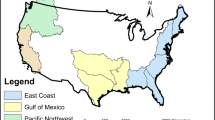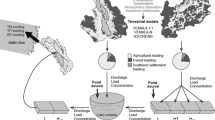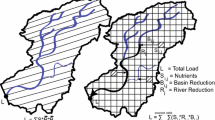Abstract
World-wide eutrophication of estuaries has made accurate estimation ofland-derived nitrogen loads an important priority. In this paper we verifypredictions of nitrogen loads made by the Waquoit Bay Nitrogen LoadingModel (NLM). NLM is appropriate for watersheds with mixes of forested,agricultural, and residential land uses, and underlain by coarseunconsolidated sediments. NLM tracks the fate of nitrogen inputs byatmospheric deposition, fertilizer use, and wastewater disposal, and assignslosses of nitrogen from each source as the nitrogen is transported throughthe land use mosaic on the watershed surface, then through the underlyingsoils, vadose zones, and aquifers.
We verified predictions of nitrogen loads by NLM in two independent ways.First, we compared NLM predictions to measured nitrogen loads in differentsubestuaries in the Waquoit Bay estuarine system. Nitrogen loads predictedby NLM were statistically indistinguishable from field-measured nitrogenloading rates. The fit of model predictions to measurements remained goodacross the wide range of nitrogen loads, and across a broad range in size(10–10,000 ha) of land parcels. NLM predictions were most precise whenspecific parcels were larger than 200 ha, and within factors of 2 for smallerparcels.
Second, we used NLM to predict the percentage of nitrogen loads toestuaries contributed by wastewater, and compared this prediction to theδ15N signature distinguishable from N derived fromatmospheric or fertilizer sources. The greater the contribution ofwastewater, the heavier the δ15N value in groundwater. Thesignificant linear relation between NLM predictions of percent wastewatercontributions and stable isotopic signature corroborated the conclusionthat model outputs provide a good match to empirical measurements. Thegood agreement obtained in both verification exercises suggests that NLMis an useful tool to address basic and applied questions about how land usepatterns alter the fate of nitrogen traversing land ecosystems, and thatNLM provides verified estimates of the land-derived nitrogen exports thattransform receiving aquatic ecosystems.
Similar content being viewed by others
References
Aravena RM, Evans ML & Cherry JA (1993) Stable isotopes of oxygen and nitrogen in source identification of nitrate from septic systems. Ground Water 31: 180–186
Caraco NF & Cole J (1999) Human impact on nitrate export: An analysis using major world rivers. Ambio 28: 167–170
Cole JJ, Peierls BL, Caraco NF & Pace ML (1993) Nitrogen loading of rivers as a humandriven process. In: McDonnell MJ & Pickett STA (Eds) Humans as Components of Ecosystems: The Ecology of Subtle Human Effects and Populated Areas (pp 138–154). Springer-Verlag, New York, New York, U.S.A.
D'Elia CF, Steudler PA & Corwin N (1977) Determination of total nitrogen in aqueous samples using persulfate digestion. Limnol. Oceanogr. 22: 760–764
GESAMP (1990) State of the Marine Environment. Reports and Studies No. 39. Joint Group of Experts on the Scientific Aspects of Marine Pollution. United Nations Environment Programme
Goldberg ED (1995) Emerging problems in the coastal zone for the twenty-first century. Mar. Poll. Bull. 31: 152–158
Gormly JR & Spalding FR (1979) Sources and concentrations of nitrate-nitrogen in ground water of the central Platte region, Nebraska. Ground Water 17: 291–301
Fourqurean JW, Moore TO, Fry B & Hollibaugh JT (1997) Spatial and temporal variation in C:N:P ratios, _15N, and _13C of eelgrass Zostera marina as indicators of ecosystem processes, Tomales Bay, California, U.S.A. Mar. Ecol. Prog. Ser. 157: 147–157
Freyer HD & Aly AIM (1974) Nitrogen-15 variations in fertilizer nitrogen. J. Envir. Qual. 3: 405–406
Holmes RM, McClelland JW, Sigman DM, Fry B & Peterson BJ (1998) Measuring 15N-NH4 in marine, estuarine, and freshwaters: An adaptation of the ammonia diffusion method for samples with low ammonium concentrations. Mar. Chem. 60: 235–243
Howarth RW(1988) Nutrient limitation of net primary production in marine ecosystems. Ann. Rev. Ecol. Syst. 19: 89–110
Hurlbert SH (1984) Pseudoreplication and the design of ecological field experiments. Ecol. Monogr. 54: 187–211
Kohl DH, Shearer GB & Commoner B (1973) Variation of 15N in corn and soil following application of fertilizer nitrogen. Soil Sci. Soc. Amer. Proc. 37: 88–892
Kreitler CW & Jones DC (1975) Natural soil nitrate: The cause of the nitrate contamination of ground water in Runnels County, Texas. Gound Water 13: 53–61
Kreitler CW (1975) Determining the Source of Nitrate in Groundwater by Nitrogen Isotope Studies. Report 83. Bureau of Economic Geology, University of Texas, Austin
Kreitler CW, Ragone S & Katz BG (1978) N15/N14 ratios of ground-water nitrate, Long Island, New York. Ground Water 16: 404–409
LeBlanc D, Garabedian SP, Hess KM, Gelhar LW, Quadri TD, Stollenwerk KG & Wood WW (1991) Large-scale natural gradient tracer test in sand and gravel, Cape Cod, Massachusetts. Water Resour. Res. 27: 895–910
Macko SA & Ostrom NE (1994) Pollution studies using stable isotopes. In: Lajtha K & Michener RH (Eds) Stable Isotopes in Ecology (pp 45–62). Blackwell Scientific Publications, London
Mariotti A & Létolle R (1977) Application de l'étude isotopique de l'azote en hydrologie et en hydrogeologie - Analyse des résultats obtenus sur un example précis: Le Bassin de Mélarchez (Sein-et-Marne, France). J. Hydrol. 33: 157–172
McClelland JW & Valiela I (1998) Linking nitrogen in estuarine producers to land-derived sources. Limnol. Oceanogr. 43: 577–585
McClelland JW, Valiela I & Michener R (1997) Nitrogen stable isotope signatures in estuarine food webs: A record of increasing urbanization in coastal watersheds. Limnol. Oceanogr. 42: 930–937
McDonald MG & Harbaugh AW (1988) A modular three-dimensional finite-difference groundwater flow model. U.S. Geological Survey Open File Report 83–875
National Research Council (NRC) (1994) Priorities for Coastal Science. National Academy Press, Washington, D.C.
Nixon SW (1986) Nutrients and the productivity of estuarine and coastal marine ecosystems. J. Limnol. Soc. S. Africa12: 43–71
Oldale RN (1992) Cape Cod and the Islands: The Geologic Story. Parnassus Imprints, Massachusetts
Portniaguine O & Solomon DK (1998) Parameter estimation using groundwater age and head data, Cape Cod, Massachusetts. Water Resour. Res. 34: 637–645
Sham CH, Brawley JW & Moritz MA (1995) Quantifying septic nitrogen loading to receiving waters: Waquoit Bay, Mass. Int. J. Geogr. Inf. Sys. 9: 463–473
Sigman DM, Altabet MA, Michener R, McCorckle DC, Fry B & Holmes RM (1997) Natural abundance-level measurement of the nitrogen isotopic composition of oceanic nitrate: An adaptation of the ammonium diffusion method. Mar. Chem. 57: 227–242
Sokal RR & Rohlf FJ (1995) Biometry: The Principles and Practice of Statistics in Biological Research (3rd edn). W. H. Freeman & Co., New York 293
Solomon DK, Poreda RJ, Cook PG & Hunt A (1995) Site characterization using 3H/3He groundwater ages, Cape Cod, Massachusetts. Ground Water 33: 988–996
Steel RGD & Torrie JH (1960) Principles and Procedures of Statistics. McGraw-Hill Book Co., Inc., New York
Valiela I. & Costa JE (1988) Eutrophication of Buttermilk Bay, a Cape Cod coastal embayment: Concentrations of nutrients and watershed nutrient budgets. Environ. Manag.12: 539–553
Valiela I, Foreman K, LaMontagne M, Hersh D, Costa J, Peckol P, DeMeo-Anderson B, D'Avanzo C, Babione M, Sham CH, Brawley J & Lajtha K (1992) Couplings of watershedsand coastal waters: Sources and consequences of nutrient enrichment in Waquoit Bay, Massachusetts. Estuaries 15: 443–457
Valiela I (1995) Marine Ecological Processes (2nd edn). Springer-Verlag, New York
Valiela I, Collins G, Kremer J, Lajtha K, Geist M, Seely B, Brawley J & Sham CH (1997) Nitrogen loading from coastal watersheds to receiving estuaries: New method and application. Ecol. Appl. 7: 358–380
Valiela I, McClelland J, Hauxwell J, Behr PJ, Hersh D & Foreman K (1998) Macroalgal blooms in shallow estuaries: Controls and ecophysiological and ecosystem consequences. Limnol. Oceanogr. 42: 1108–1115
Zar JH (1984) Biostatistical Analysis (2nd edn). Prentice-Hall International, Inc., New Jersey
Author information
Authors and Affiliations
Rights and permissions
About this article
Cite this article
Valiela, I., Geist, M., McClelland, J. et al. Nitrogen loading from watersheds to estuaries: Verification of the Waquoit Bay Nitrogen Loading Model. Biogeochemistry 49, 277–293 (2000). https://doi.org/10.1023/A:1006345024374
Issue Date:
DOI: https://doi.org/10.1023/A:1006345024374




